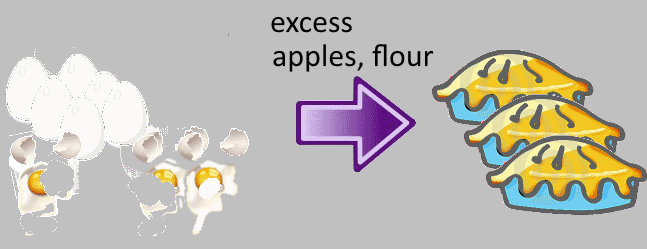





A diesel engine provides only 45 % of the power which it could provide if the whole energy liberated by the combustion was transformed to usable energy. The losses have multiple causes which are mostly anavoidable.


To make an apple cake , you need 3 apples, 2 eggs and enough flour.
 Unfortunately this time three apples were rotten and with your 12 apples you can make only 3 cakes, while you had planned for 4 !
The yield with respect to the apples is
$\rho$ $=$ $\frac{3}{4}$ $=$
$0.75$
or
$\rho$ $=$ $75\%$
(from the $100\%$ that you should have made).
Unfortunately this time three apples were rotten and with your 12 apples you can make only 3 cakes, while you had planned for 4 !
The yield with respect to the apples is
$\rho$ $=$ $\frac{3}{4}$ $=$
$0.75$
or
$\rho$ $=$ $75\%$
(from the $100\%$ that you should have made).
 Unfortunately this time 3 eggs were broken and with 9 eggs you realise only 3 cakes, while you had planned for $\frac{9}{2}$ ! !
The yield with respect to the eggs is
$\rho$ $=$ $\frac{3}{\frac{9}{2}}=0.666$
or
$\rho$ $=$ $66.6\%$
(from the $100\%$ that you should have made).
Unfortunately this time 3 eggs were broken and with 9 eggs you realise only 3 cakes, while you had planned for $\frac{9}{2}$ ! !
The yield with respect to the eggs is
$\rho$ $=$ $\frac{3}{\frac{9}{2}}=0.666$
or
$\rho$ $=$ $66.6\%$
(from the $100\%$ that you should have made).
The yield of a chemical reaction is the ration of the number of moles of a product obtained actually by the number of moles of this producttheoretically obtainable. $\rho=\frac{n_{actually\; obtained}}{n_{theoretically\; obtainable}}$ The yield is often given in %, then $\rho$ is multiplied by 100: $\rho_{\%}$ $=$ $\frac{n_{actually\; obtained}\cdot 100}{n_{theoretically\; obtainable}}$

3 molecules $H_2$ should give 3 molecules $H_2O$ but actually they produce only 2 (because of losses while water is collected, lack of watertight integrity of the containers, etc...) The yield with respect to hydrogen is therefore $\rho$ $=$ $\frac{2}{3}$ $=$ $0.666$ or $\rho$ $=$ $66.6\%$
.